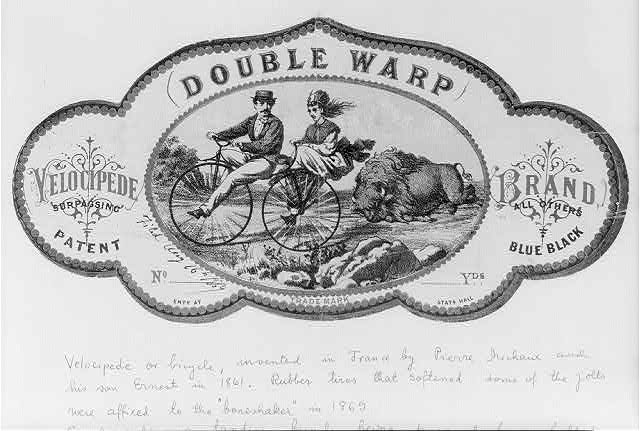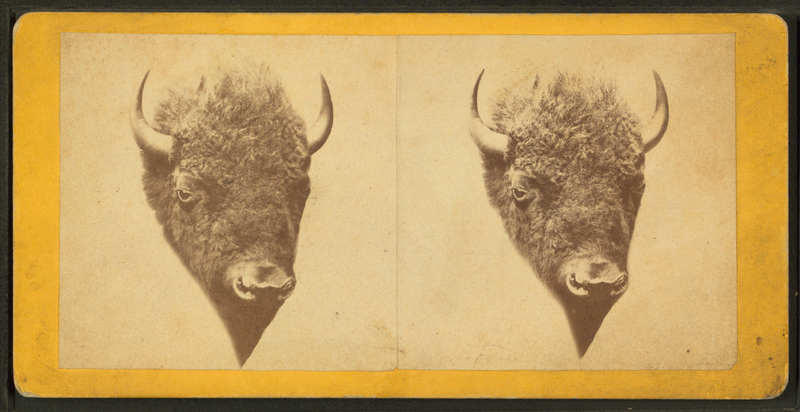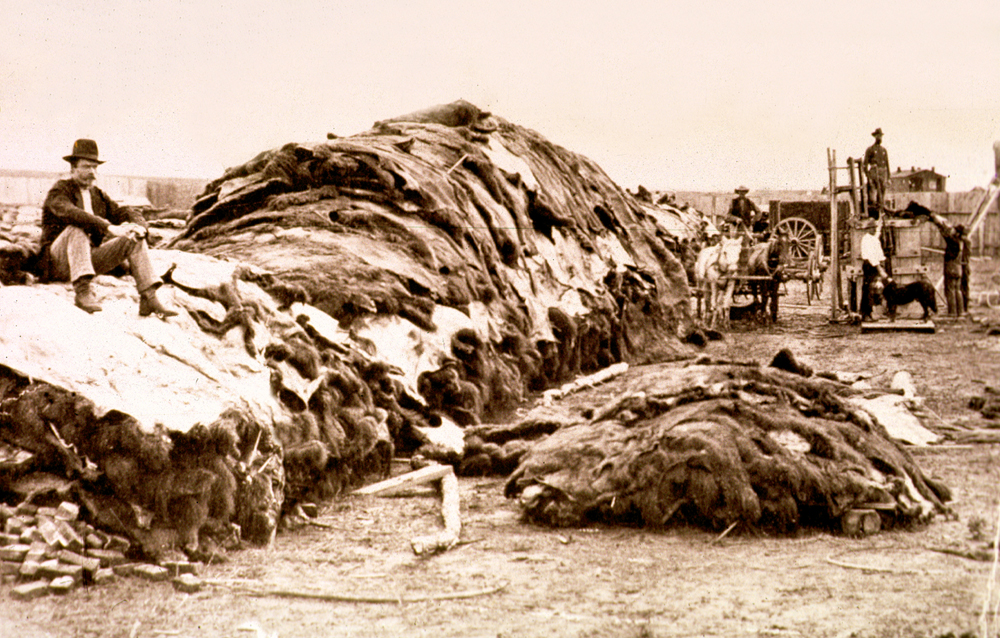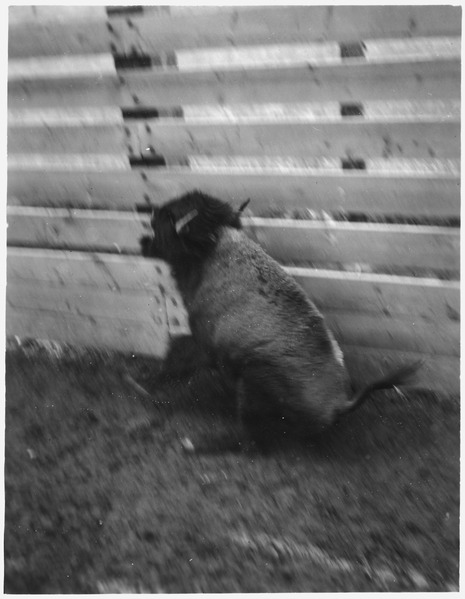.

Three Dakota men, seated or kneeling on ground, one attending to bison skull: Saliva, Slow Bull (in background), Picket Pin's arm: photo by Edward S. Curtis, c. 1907 (Edward S. Curtis Collection, Library of Congress))

The Oath -- Apsaroke. Three Apsaroke men [Goes Ahead (center) and Pretty Tail (left)] gazing skyward, two holding rifles, one with object skewered on arrow pointed skyward, bison skull at their feet: photo by Edward S. Curtis, 19 November c.1908 (Edward S. Curtis Collection, Library of Congress)

The offering -- Hu Kalowa Pi ceremony; Teton Indian, Slow Bull (?), holding pipe (?) on side of bison: photo by Edward S. Curtis, 1907 ( (Edward S. Curtis Collection, Library of Congress)

Hu Kalawa Pi, the altar complete: three Native Americans, Slow Bull, Saliva, and Picket Pin, kneeling with bison skull: Edward S. Curtis, 1907 ( (Edward S. Curtis Collection, Library of Congress)

1867 -- The evolution of the West in four decades -- 1907: J.L. Loveday, c. 1906 (Library of Congress)

[Indians hunting bison on horses covered with bison skins]: Frederic L, Remington, 1908: photo by P. F Collier for Detroit Publishing Company, c. 1908 (Library of Congress)

Doomed: Charles Schreyvgel, c. 1901 (Library of Congress)

[American Indian man on horseback killing bison]: Augustus Kollner, 185(-] (Library of Congress)

Pan-American [illustration showing Columbia and another woman, possibly representing South America, riding side-saddle on a Buffalo to the Pan-American Exposition in Buffalo, New York]: Udo J. Keppler, from Puck, 8 May 1901 (Library of Congress)

The Great Pawnee Bill shows. The only genuine wild west. Touring America ...: circus advertisement, c. 1903 (Library of Congress)

Advertising label for Double-warp Velocipede Brand fabric, showing bison pursuing couple on bicycle-built-for-two: c. 1869 (Library of Congress)

American bison: photo by Pelck's Scenic Art & Studio, c. 1906 (Library of Congress)

Last remnants of the American Bison, Yellowstone National Park: photo by American Stereoscopic Company, c. 1903 (Library of Congress)

The Lucky Buffalo Hunter: photo by Truman Ingersoll Ward, c. 1897 (Library of Congress)

American Bison on the obverse of 1901 U.S. $10 note: image by Red devil, 11 February 2006
Buffalo shot while running through corral: photo by Department of the Interior/U.S. Fish and Wildlife Service, Albuquerque Regional Office, Wichita Mountains Wildlife Refuge, 1936 (National Archives and Records Administration)

Animated sequence of a buffalo (American Bison) galloping : photos by Eadweard Muybridge, from Animal Locomotion, Philadelphia, 1887; animation by Waugsberg, 16 July 2007

Edward Estlin Cummings: Buffalo Bill's/defunct, from Seven Poems in The Dial, January 1920 (image by Blankfaze, 2005)

Head of a buffalo: photographer unknown, 1870s, Robert N. Dennis collection of stereoscopic views (Stephen A. Schwarzman Photography Collection, Miriam and Ira D. Wallach Division of Art, Prints and Photographs, New York Public Library)

A stack of buffalo hides at a Dodge City hide yard. Commercial buffalo hunters slaughtered the animals by the thousands and left their carcasses to rot on the Plains: photographer unknown, c. 1870s (Kansas State Historical Society)

A pile of American Bison skulls waiting to be ground for fertilizer: photographer unknown, mid-1870s (image by Chick Bowen, 27 May 2011)
Of all the quadrupeds that have lived upon the earth, probably no other species has ever marshaled such innumerable hosts as those of the American bison. It would have been as easy to count or to estimate the number of leaves in a forest as to calculate the number of buffaloes living at any given time during the history of the species previous to 1870. Even in South Central Africa, which has always been exceedingly prolific in great herds of game, it is probable that all its quadrupeds taken together on an equal area would never have more than equaled the total number of buffalo in this country forty years ago.
.
During the two great periods of slaughter -- 1870-’75 and 1880-’84 -- the principal killing grounds were as well known as the stock-yards of Chicago. Had proper laws been enacted, and had either the general or territorial governments entered with determination upon the task of restricting the killing of buffaloes to proper limits, their enforcement would have been, in the main, as simple and easy as the collection of taxes. Of course the solitary hunter in a remote locality would have bowled over his half dozen buffaloes in secure defiance of the law; but such desultory killing could not have made much impression on the great mass for many years. The business-like, wholesale slaughter, wherein one hunter would openly kill five thousand buffaloes and market perhaps two thousand hides, could easily have been stopped forever. Buffalo hides could not have been dealt in clandestinely, for many reasons, and had there been no sale for ill-gotten spoils the still-hunter would have gathered no spoils to sell. It was an undertaking of considerable magnitude, and involving a cash outlay of several hundred dollars to make up an “outfit” of wagons, horses, arms and ammunition, food, etc., for a trip to “the range” after buffaloes. It was these wholesale hunters, both in the North and the South, who exterminated the species, and to say that all such undertakings could not have been effectually prevented by law is to accuse our law-makers and law-officers of imbecility to a degree hitherto unknown. There is nowhere in this country, nor in any of the waters adjacent to it, a living species of any kind which the United States Government can not fully and perpetually protect from destruction by human agencies if it chooses to do so. The destruction of the buffalo was a loss of wealth perhaps twenty times greater than the sum it would have cost to conserve it, and this stupendous waste of valuable food and other products was committed by one class of the American people and permitted by another with a prodigality and wastefulness which even in the lowest savages would be inexcusable.


No comments:
Post a Comment